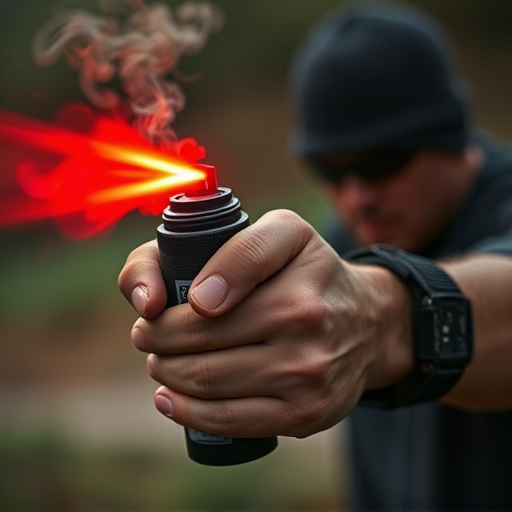The effectiveness of pepper spray relies on its capsaicin derivatives, which temporarily disrupt vision and breathing. Balancing potency with safety is crucial for legal compliance and user/bystander health. The strongest legal pepper spray ingredients typically contain 10%-25% capsaicin, with lower concentrations (2%) approved for civilian self-defense and higher strengths (up to 15%) for specialized tactical units. These formulations, driven by chili pepper compounds like capsaicinoids and piperine, cause temporary incapacitation through eye and respiratory irritation, making them essential tools for law enforcement and personal defense while adhering to safety regulations.
“In the realm of law enforcement, pepper spray stands as a crucial tool for crowd control and self-defense. This article delves into the science behind police-grade inflammatory pepper spray compounds, focusing on understanding the strongest legal pepper spray ingredients. From the composition of active substances to their legal standing, we explore how these innovative formulations balance efficacy and safety. By examining common ingredients and their proven track record, readers gain insights into responsible application, ensuring both effectiveness in critical situations and minimal risk to users and bystanders.”
- Understanding Pepper Spray Composition: Unveiling the Active Ingredients
- Legal Considerations and Regulations for Pepper Spray Strength
- The Science Behind the 'Strongest' Pepper Spray Compound
- Exploring Common Pepper Spray Ingredients and Their Efficacy
- Safety and Use Cases: Responsible Application of Police-Grade Pepper Spray
Understanding Pepper Spray Composition: Unveiling the Active Ingredients
Pepper spray, a widely used non-lethal self-defense tool, is more than just a simple mixture of chemicals. At its core, it’s a carefully crafted compound designed to disrupt an attacker’s vision and breathing for a short period, providing the user with precious time to escape or defend themselves. Understanding the composition, particularly the active ingredients, is crucial when assessing its effectiveness and potential impact on users and bystanders.
The strongest legal pepper spray ingredients are often derivatives of capsaicin, the chemical responsible for the heat sensation in chili peppers. These compounds mimic natural capsaicinoids, targeting nerve endings in the eyes and respiratory system. The most potent variants can cause immediate disorientation, temporary blindness, and severe coughing, making them powerful deterrents. However, manufacturers must balance effectiveness with safety, ensuring that the spray remains legal and doesn’t pose significant health risks to users or bystanders.
Legal Considerations and Regulations for Pepper Spray Strength
The legality and regulation of pepper spray strength vary across jurisdictions, but a key consideration revolves around balancing effectiveness with safety. In many countries, law enforcement agencies are permitted to use pepper spray with specific capsaicin concentrations, ensuring it’s potent enough for crowd control yet not excessively harmful to bystanders or officers. The strongest legal pepper spray ingredients typically contain capsaicin in the range of 10% to 25%, though formulations can differ.
Regulators often set guidelines based on factors like intended use, potential risks, and available de-escalation techniques. For instance, lower concentrations (around 2%) might be approved for civilian self-defense, while higher strengths (up to 15%) may be reserved for specialized tactical units within law enforcement. These regulations aim to strike a delicate balance, ensuring that pepper spray remains an effective tool for maintaining public safety and order without causing excessive pain or long-term harm.
The Science Behind the 'Strongest' Pepper Spray Compound
The science behind the ‘strongest’ pepper spray compound involves a deep understanding of capsaicinoids, the active ingredients derived from chili peppers. These compounds bind to receptors in the nose and eyes, triggering a burning sensation that can incapacitate an individual temporarily. The strongest legal pepper spray ingredients often include higher concentrations of capsaicin or its synthetic equivalents, which significantly enhance their effectiveness.
Research and development in this field have led to innovative formulations that not only increase the potency but also improve safety and ease of use. These advancements ensure that pepper spray remains a crucial tool for law enforcement while adhering to legal standards and minimizing potential harm to both suspects and officers.
Exploring Common Pepper Spray Ingredients and Their Efficacy
In the world of law enforcement and personal defense, pepper spray has long been a trusted tool for deterring potential threats. The key to its effectiveness lies in the ingredients used, particularly the strongest legal pepper spray compounds available. One of the primary active ingredients is capsaicin, derived from chili peppers, which irritates the eyes, nose, and respiratory system, temporarily disabling the target.
Beyond capsaicin, other potent ingredients such as piperine, a synthetic form of black pepper, and various cayenne pepper derivatives enhance the spray’s effectiveness. These compounds not only increase pain but also reduce visibility and breathing capabilities, making them ideal for self-defense scenarios. Understanding these ingredients is crucial in selecting the most efficient and legal pepper spray for personal protection.
Safety and Use Cases: Responsible Application of Police-Grade Pepper Spray
Police-grade inflammatory pepper spray is designed for professional law enforcement use, making it a powerful tool in high-risk situations. Its primary purpose is to temporarily incapacitate individuals, providing officers with the time and space needed to control and de-escalate potentially dangerous scenarios. The compounds used in these sprays are meticulously formulated to be both effective and safe when handled by trained professionals.
When used responsibly, strongest legal pepper spray ingredients can help reduce injuries and minimize damage during arrests or crowd control. These sprays target the eyes, nose, and respiratory system, causing a burning sensation that temporarily blinds and disorients the affected individual. This strategic application ensures officer safety while de-escalating conflicts, making it an indispensable tool in modern policing tactics.
The quest for the strongest legal pepper spray ingredients has led to significant advancements in non-lethal force technologies. By understanding the science behind these compounds and navigating the legal considerations, law enforcement agencies can leverage the efficacy of pepper spray as a safe and effective tool. The exploration of various active ingredients reveals a balance between potency and responsible use, ensuring that officers have the necessary tools while prioritizing safety for all involved.
